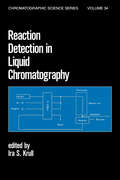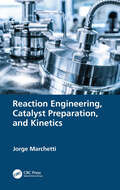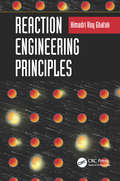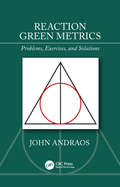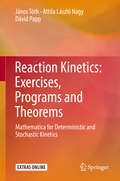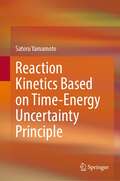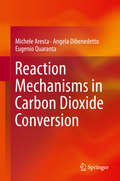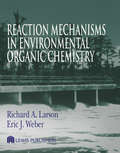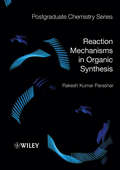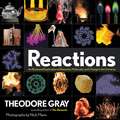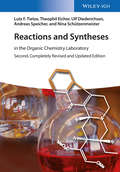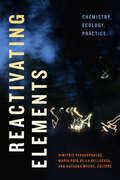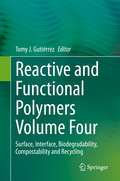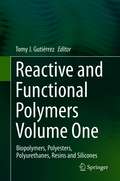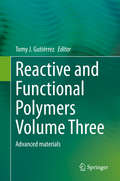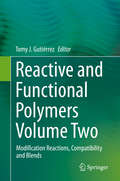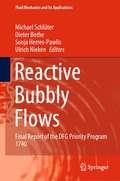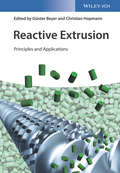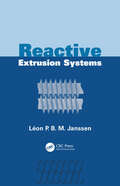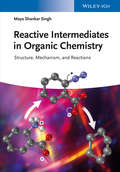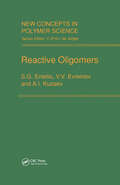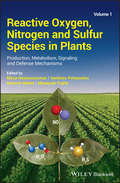- Table View
- List View
Reaching for the Sun
by John KingFrom their ability to use energy from sunlight to make their own food, to combating attacks from diseases and predators, plants have evolved an amazing range of life-sustaining strategies. Written with the non-specialist in mind, John King's lively natural history explains how plants function, from how they gain energy and nutrition to how they grow, develop and ultimately die. New to this edition is a section devoted to plants and the environment, exploring how problems created by human activities, such as global warming, pollution of land, water and air, and increasing ocean acidity, are impacting on the lives of plants. King's narrative provides a simple, highly readable introduction, with boxes in each chapter offering additional or more advanced material for readers seeking more detail. He concludes that despite the challenges posed by growing environmental perils, plants will continue to dominate our planet.
Reaction Detection in Liquid Chromatography (Chromatographic Science Ser. #34)
by Ira S. KrullThe first book to focus entirely on reactions for analyte detection and characterization,Reaction Detection in Liquid Chromatography depicts off- and on-line, pre- and postcolumnapproaches that have been successfully used for many classes of compounds, bothorganic and inorganic, in high performance liquid chromatography.The book gives special attention to methods and instrumentation associated with postcolumnreaction detection, discussing theory, background, principles, and equations .. .and also highlights major areas of reaction chemistry, such as immobilized ( or solution)enzymatic reactions, homogenous solution chemistry, photochemical derivation, pairedionreagents, solid phase and solid supported reagents, and reactions for inorganic species.In addition, Reaction Detection in liquid Chromatography details the efficiencies of thevarious reactions surveyed ... forecasts how the utility of each reaction is likely to be enhancedby new research ... and gives data that will allow the reader to reproducereaction-detection approaches for new analytes and samples.Reaction Detection in Liquid Chromatography is essential reading for analytical, bioanalytical,quality control, and research and development chemists. It also comprises a finereference for analysts involved in development and applications of liquid chromatographyfor specific qualitative and quantitative analyte identification; and in-house, professionalseminars.
Reaction Engineering, Catalyst Preparation, and Kinetics
by Jorge MarchettiThis book serves as an introduction to the subject, giving readers the tools to solve real-world chemical reaction engineering problems. It features a section of fully solved examples as well as end of chapter problems. It includes coverage of catalyst characterization and its impact on kinetics and reactor modeling. Each chapter presents simple ideas and concepts which build towards more complex and realistic cases and situations. Introduces an in-depth kinetics analysis Features well developed sections on the major topics of catalysts, kinetics, reactor design, and modeling Includes a chapter that showcases a fully worked out example detailing a typical problem that is faced when performing laboratory work Offers end of chapter problems and a solutions manual for adopting professors Aimed at advanced chemical engineering undergraduates and graduate students taking chemical reaction engineering courses as well as chemical engineering professionals, this textbook provides the knowledge to tackle real problems within the industry.
Reaction Engineering Principles
by Himadri Roy GhatakChemical reaction engineering is at the core of chemical engineering education. Unfortunately, the subject can be intimidating to students, because it requires a heavy dose of mathematics. These mathematics, unless suitably explained in the context of the physical phenomenon, can confuse rather than enlighten students. Bearing this in mind, Reaction Engineering Principles is written primarily from a student’s perspective. It is the culmination of the author’s more than twenty years of experience teaching chemical reaction engineering. The textbook begins by covering the basic building blocks of the subject—stoichiometry, kinetics, and thermodynamics—ensuring students gain a good grasp of the essential concepts before venturing into the world of reactors. The design and performance evaluation of reactors are conveniently grouped into chapters based on an increasing degree of difficulty. Accordingly, isothermal reactors—batch and ideal flow types—are addressed first, followed by non-isothermal reactor operation, non-ideal flow in reactors, and some special reactor types. For better comprehension, detailed derivations are provided for all important mathematical equations. Narrative of the physical context in which the formulae work adds to the clarity of thought. The use of mathematical formulae is elaborated upon in the form of problem solving steps followed by worked examples. Effects of parameters, changing trends, and comparisons between different situations are presented graphically. Self-practice exercises are included at the end of each chapter.
Reaction Green Metrics: Problems, Exercises, and Solutions
by John AndraosThis book contains a series of exercises and problems posed in the subject of green metrics. Essentially it is a "how to" book on evaluating the material efficiency, environmental impact, safety-hazard impact, and energy efficiency of any kind of chemical reaction or synthesis plan. Only the essential green metrics in each of these categories are used. The introduction highlights the hierarchy of metrics used throughout the book, explains the structure of how the book is arranged, how the problems are posed, and how the reader is to use the book. Examples refer to themes according to the headings given in the table of contents and are arranged in a hierarchical order.
Reaction Kinetics: An Introduction
by Ernő KeszeiThis book covers all basic topics of reaction kinetics, thus students do not need to refer to other resources to prepare for an undergraduate exam. It leads the reader into the topic starting from molecular level concepts and working towards the more macroscopic descriptions of kinetics, introducing the subject according to the state-of-the-art 21st century chemistry. A thorough treatment of formal kinetics of both elementary and complex reactions is based on actual practice, omitting many obsolete treatments of the subject. Mathematical operations are explained in enough detail so that even students that are less trained in calculus can easily follow and understand. Data treatment and statistical inference include modern - mostly numerical - methods widely used in applications. Experimental methods are described using basic technical details, however as techniques quickly change sophisticated devices are not the focus of this book. The emphasis lies on providing the basic concepts which are important for students to understand. This book is suitable as essential reading for courses in bachelor and master chemistry programs and is also valuable as a reference or textbook for students of physics, biochemistry and environmental science.
Reaction Kinetics: Mathematica for Deterministic and Stochastic Kinetics
by János Tóth Attila László Nagy Dávid PappFifty years ago, a new approach to reaction kinetics began to emerge: one based on mathematical models of reaction kinetics, or formal reaction kinetics. Since then, there has been a rapid and accelerated development in both deterministic and stochastic kinetics, primarily because mathematicians studying differential equations and algebraic geometry have taken an interest in the nonlinear differential equations of kinetics, which are relatively simple, yet capable of depicting complex behavior such as oscillation, chaos, and pattern formation. The development of stochastic models was triggered by the fact that novel methods made it possible to measure molecules individually. Now it is high time to make the results of the last half-century available to a larger audience: students of chemistry, chemical engineering and biochemistry, not to mention applied mathematics. Based on recent papers, this book presents the most important concepts and results, together with a wealth of solved exercises. The book is accompanied by the authors’ Mathematica package, ReactionKinetics, which helps both students and scholars in their everyday work, and which can be downloaded from http://extras.springer.com/ and also from the authors’ websites. Further, the large set of unsolved problems provided may serve as a springboard for individual research.
Reaction Kinetics Based on Time-Energy Uncertainty Principle
by Satoru YamamotoThis book proposes a completely unique reaction kinetics theory based on the uncertainty principle of quantum mechanics; the physical viewpoint and mathematical details for the theory construction are explained, and abundant applications of the theory mainly in materials science are described. The theory argues that physical systems on reaction are in a quantum-mechanically uncertain state, and that such systems will transition to new states after a finite duration time. Based on this theory, if the magnitude of the energy uncertainty, i.e., energy fluctuation of the system on reaction can be determined, we can calculate the reaction rates not only for the thermal activation processes but also for the non-thermal activation process such as mechanical, optical, electromagnetic, or other actions. Therefore, researchers or engineers who are involved in fields such as the discovery of new chemical substances, development of materials, innovation of manufacturing processes, and also everyone purely interested in kinetic methodology find this book very stimulating and motivating.
Reaction Mechanisms in Carbon Dioxide Conversion
by Michele Aresta Angela Dibenedetto Eugenio QuarantaThis book provides an analysis of the reaction mechanisms relevant to a number of processes in which CO2 is converted into valuable products. Several different processes are considered that convert CO2 either in specialty chemicals or in bulk products or fuels. For each reaction, the mechanism is discussed and the assessed steps besides the dark sites of the reaction pathway are highlighted. From the insertion of CO2 into E-X bonds to the reduction of CO2 to CO or other C1 molecules or else to C2 or Cn molecules, the reactions are analysed in order to highlight the known and obscure reaction steps. Besides well known reaction mechanisms and energy profiles, several lesser known situations are discussed. Advancing knowledge of the latter would help to develop efficient routes for the conversion of CO2 into valuable products useful either in the chemical or in the energy industry. The content of this book is quite different from other books reporting the use of CO2. On account of its clear presentation, "Reaction Mechanisms in Carbon Dioxide Conversion" targets in particular researchers, teachers and PhD students.
Reaction Mechanisms in Environmental Organic Chemistry
by RichardA. LarsonReaction Mechanisms in Environmental Organic Chemistry classifies and organizes the reactions of environmentally important organic compounds using concepts and data drawn from traditional mechanistic and physical organic chemistry. It will help readers understand these reactions and their importance for the environmental fates or organic compounds of many types. The book has a molecular and mechanistic emphasis, and it is organized by reaction type. Organic molecules and their fates are examined in an ecosystem context. Their reactions are discussed in terms that organic chemists would use. The book will benefit organic chemists, environmental engineers, water treatment professionals, hazardous waste specialists, and biologists. Although conceived as a comprehensive monograph, the book could also be used as a text or reference for environmental chemistry classes at the undergraduate or graduate level.
Reaction Mechanisms in Organic Synthesis (Postgraduate Chemistry Series)
by Rakesh Kumar ParasharOrganic chemistry is a core part of the chemistry curricula, and advanced levels texts often obscure the essential framework underlying and uniting the vast numbers of reactions as a result of the high level of detail presented. The material in this book is condensed into a manageable text of 350 pages and presented in a clear and logical fashion, focusing purely on the basics of the subject without going through exhaustive detail or repetitive examples. The book aims to bridge the gap between undergraduate organic chemistry textbooks and advanced level textbooks, beginning with a basic introductory course and arranging the reaction mechanisms according to an ascending order of difficulty. As such, the author believes the book will be excellent primer for advanced postgraduates Reaction Mechanisms in Organic Synthesis is written from the point of view of the synthetic organic chemist, enabling students and researchers to understand and expand on reactions covered in foundation courses, and to apply them in a practical context by designing syntheses. As a further aid to the practical research student, the content is organized according to the conditions under which a reaction is executed rather than by the types of mechanisms. Particular emphasis is placed on controlling stereospecificity and regiospecificity. Topics covered include: Transition metal mediated carbon-carbon bond formation reactions Use of stabilized carbanions, ylides and enamines for carbon-carbon bond formation reactions, Advanced level use of oxidation and reduction reagents in synthesis. As a modern text, this book stands out from its competitors due to its comprehensive coverage of recently published research. The book contains specific examples from the latest literature, covering modern reactions and the latest procedural modifications. The focus on contemporary and synthetically useful reactions ensures that the contents are specifically relevant and attractive to postgraduate students and industrial organic chemists.
Reactions: An Illustrated Exploration of Elements, Molecules, and Change in the Universe
by Theodore GrayThe long-awaited third installment in Theodore Gray's iconic "Elements" trilogy. The first two titles, Elements and Molecules, have sold more than 1.5 million copies worldwide. With Reactions bestselling author Theodore Gray continues the journey through our molecular and chemical world that began with the tour de force The Elements and continued with Molecules. In The Elements, Gray gave us a never-before-seen, mesmerizing photographic view of the 118 elements in the periodic table. In Molecules, with the same phenomenal photographic acumen, plus beautifully rendered computer generated graphics, he showed us how the elements combine to form the content that makes up our universe, from table salt to oxygen to the panoply of colors and smells that surround us. At last, we've reached Reactions, in which Gray once again puts his photography and storytelling to work demonstrating how molecules interact in ways that are essential to our very existence. The book begins with a brief recap of elements and molecules and then goes on to explain important concepts the characterize a chemical reaction, including Energy, Entropy, and Time. It is then organized by type of reaction including chapters such as "Fantastic Reactions and Where to Find Them," "On the Origin of Light and Color," "The Boring Chapter," in which we learn about reactions such as paint drying, grass growing, and water boiling, and "The Need for Speed," including topics such as weather, ignition, and fire.
Reactions and Syntheses
by Lutz F. Tietze Ulf Diederichsen Andreas Speicher Nina Schützenmeister Theophil EicherThe second edition of this classic text book has been completely revised, updated, and extended to include chapters on biomimetic amination reactions, Wacker oxidation, and useful domino reactions.The first-class author team with long-standing experience in practical courses on organic chemistry covers a multitude of preparative procedures of reaction types and compound classes indispensable in modern organic synthesis. Throughout, the experiments are accompanied by the theoretical and mechanistic fundamentals, while the clearly structured sub-chapters provide concise background information, retrosynthetic analysis, information on isolation and purification, analytical data as well as current literature citations. Finally, in each case the synthesis is labeled with one of three levels of difficulty.An indispensable manual for students and lecturers in chemistry, organic chemists, as well as lab technicians and chemists in the pharmaceutical and agrochemical industries.
Reactivating Elements: Chemistry, Ecology, Practice (Elements)
by Dimitris Papadopoulos, Maria Puig De La Bellacasa, & Natasha MyersThe contributors to Reactivating Elements examine chemicals as they mix with soil, air, water, and fire to shape Earth's troubled ecologies today. They invoke the elements with all their ambivalences as chemical categories, material substances, social forms, forces and energies, cosmological entities, and epistemic objects. Engaging with the nonlinear historical significance of elemental thought across fields—chemistry, the biosciences, engineering, physics, science and technology studies, the environmental humanities, ecocriticism, and cultural studies—the contributors examine the relationship between chemistry and ecology, probe the logics that render wind as energy, excavate affective histories of ubiquitous substances such as plastics and radioactive elements, and chart the damage wrought by petrochemical industrialization. Throughout, the volume illuminates how elements become entangled with power and control, coloniality, racism, and extractive productivism while exploring alternative paths to environmental destruction. In so doing, it rethinks the relationship between the elements and the elemental, human and more-than-human worlds, today’s damaged ecosystems and other ecologies to come.Contributors. Patrick Bresnihan, Tim Choy, Joseph Dumit, Cori Hayden, Stefan Helmreich, Joseph Masco, Michelle Murphy, Natasha Myers, Dimitris Papadopoulos, María Puig de la Bellacasa, Astrid Schrader, Isabelle Stengers
Reactive and Functional Polymers Volume Four: Surface, Interface, Biodegradability, Compostability and Recycling
by Tomy J. GutiérrezReactive and functional polymers are manufactured with the aim of improving the performance of unmodified polymers or providing functionality for different applications. These polymers are created mainly through chemical reactions, but there are other important modifications that can be carried out by physical alterations in order to obtain reactive and functional polymers. This volume presents a comprehensive analysis of these reactive and functional polymers. Reactive and Functional Polymers Volume Four considers surface interactions, modifications and reactions, as well as reactive processes for recycling polymers and their biodegradability and compostability. World renowned researchers from Argentina, Austria, China, Egypt, France, Iran, Italy, Nepal and United States have participated in this book. With its comprehensive scope and up-to-date coverage of issues and trends in Reactive and Functional Polymers, this is an outstanding book for students, professors, researchers and industrialists working in the field of polymers and plastic materials.
Reactive and Functional Polymers Volume One: Biopolymers, Polyesters, Polyurethanes, Resins and Silicones
by Tomy J. GutiérrezReactive and functional polymers are manufactured with the aim of improving the performance of unmodified polymers or providing functionality for different applications. These polymers are created mainly through chemical reactions, but there are other important modifications that can be carried out by physical alterations in order to obtain reactive and functional polymers. This volume presents a comprehensive analysis of these reactive and functional polymers. Reactive and Functional Polymers Volume One provides the principles and foundations for the design, development, manufacture and processing of reactive and functional polymers based primarily on biopolymers, polyesters and polyurenthanes. The text provides an in-depth review of updated sources on reactive resins and silicones. In this book, world-renowned researchers have participated, including Dr. Runcang Sun (Associate editor for the journal ‘Carbohydrate Polymers’). With its comprehensive scope and up-to-date coverage of issues and trends in Reactive and Functional Polymers, this is an outstanding book for students, professors, researchers and industrialists working in the field of polymers and plastic materials.
Reactive and Functional Polymers Volume Three: Advanced materials
by Tomy J. GutiérrezReactive and functional polymers are manufactured with the aim of improving the performance of unmodified polymers or providing functionality for different applications. These polymers are created mainly through chemical reactions, but there are other important modifications that can be carried out by physical alterations in order to obtain reactive and functional polymers. This volume presents a comprehensive analysis of these reactive and functional polymers. Reactive and Functional Polymers Volume Three considers advanced polymeric materials such as electroactive polymers, multi-responsive polymers, shape memory polymers, stimuli responsive polymers, and active and intelligent polymers as topics for analysis. World renowned researchers from Argentina, Austria, China, Egypt, France, India, Iran, Japan, Pakistan, Romania and Spain have participated in this book. With its comprehensive scope and up-to-date coverage of issues and trends in Reactive and Functional Polymers, this is an outstanding book for students, professors, researchers and industrialists working in the field of polymers and plastic materials.
Reactive and Functional Polymers Volume Two: Modification Reactions, Compatibility and Blends
by Tomy J. GutiérrezReactive and functional polymers are manufactured with the aim of improving the performance of unmodified polymers or providing functionality for different applications. These polymers are created mainly through chemical reactions, but there are other important modifications that can be carried out by physical alterations in order to obtain reactive and functional polymers. This volume presents a comprehensive analysis of these reactive and functional polymers. Reactive and Functional Polymers Volume Two considers the coupling, crosslinking and grafting reactions to improve the compatibility of reactive and functional polymer blends. In this book, world-renowned researchers have participated, including Dr. Sabu Thomas (Editor-in-chief for the journal ‘Nano-Structures & Nano-Objects’). With its comprehensive scope and up-to-date coverage of issues and trends in Reactive and Functional Polymers, this is an outstanding book for students, professors, researchers and industrialists working in the field of polymers and plastic materials.
Reactive Bubbly Flows: Final Report of the DFG Priority Program 1740 (Fluid Mechanics and Its Applications #128)
by Michael Schlüter Dieter Bothe Sonja Herres-Pawlis Ulrich NiekenThis book presents experimental and numerical methods that have been developed during six years of targeted research within the DFG priority program SPP 1740, elucidating the interaction between hydrodynamics, mass transfer and transport as well as chemical reactions in bubbly flows. A special feature of this book is its focus on an interdisciplinary research approach with contributions from chemistry, mathematics and engineering sciences, providing enhanced or novel experimental methods, models and numerical simulations. This book provides fundamental knowledge to students about the current state of knowledge regarding transport processes in reactive bubbly flows as well as to scientists, emphasizing pressing research questions and further current demands for fundamental research. Engineers from the chemical industries will get valuable insights into relevant gas-liquid processes and benefit from recommendations concerning the design of gas-liquid reactors and laboratory experiments for studying the performance of gas-liquid reactions in their own lab.
Reactive Extrusion: Principles and Applications
by Günter Beyer Christian HopmannThis first comprehensive overview of reactive extrusion technology for over a decade combines the views of contributors from both academia and industry who share their experiences and highlight possible applications and markets. They also provide updated information on the underlying chemical and physical concepts, summarizing recent developments in terms of the material and machinery used. As a result, readers will find here a compilation of potential applications for reactive extrusion to access new and cost-effective polymeric materials, while using existing compounding machines.
Reactive Extrusion Systems
by Leon P.B.M. JanssenCiting recently realized applications for extruders as polymerization, modification, and degradation reactors and presenting a telling array of new research results and illustrative experimental cases, Reactive Extrusion Systems sheds light on the complex set of interactions underlying reactions in extruders. The book succeeds as a three-part surve
Reactive Intermediates in Organic Chemistry
by Maya Shankar SinghMost reactions in organic chemistry do not proceed in a single step but rather take several steps to yield the desired product. In the course of these multi-step reaction sequences, short-lived intermediates can be generated that quickly convert into other intermediates, reactants, products or side products. As these intermediates are highly reactive, they cannot usually be isolated, but their existence and structure can be proved by theoretical and experimental methods. Using the information obtained, researchers can better understand the underlying reaction mechanism of a certain organic transformation and thus develop novel strategies for efficient organic synthesis.The chapters are clearly structured and are arranged according to the type of intermediate, providing information on the formation, characterization, stereochemistry, stability, and reactivity of the intermediates. Additionally, representative examples and a problem section with different levels of difficulty are included for self-testing the newly acquired knowledge.By providing a deeper understanding of the underlying concepts, this is a musthave reference for PhD and Master Students in organic chemistry, as well as a valuable source of information for chemists in academia and industry working in the field. It is also ideal as primary or supplementary reading for courses on organic chemistry, physical organic chemistry or analytical chemistry.
Reactive Oligomers
by S.G. Entelis V.V. Evreinov A.I. KuzaevReactive oligomers (ROs) constitute a starting material for the production of numerous polymeric materials with a pre-assigned set of physico-mechanical and physico-chemical properties. This book is the first to treat systematically various methods for determining the FTD and MWD of functional oligomers. Special attention is given to the application of liquid chromatography in different separation modes: exclusion (gel-permeation chromatography, GPC) and adsorption, as well as to the separation of functional oligomers in the critical region (SCR) at the boundary between the specified modes.
Reactive Oxygen and Nitrogen Species Signaling and Communication in Plants
by Kapuganti Jagadis Gupta Abir U. IgamberdievThis book reviews the current state of information on reactive oxygen and nitrogen species and their role in cell communication during plant growth, development and adaptation to stress conditions. It addresses current research advances made in the area of reactive oxygen and nitrogen species (ROS and RNS) signaling. These free radical molecules are important in plant-microbe interactions, responses to abiotic stress, stomatal regulation and a range of developmental processes. Due to their short half-life, high diffusion capability and ability to react with different components in the cell, ROS and RNS participate in various processes connected with signaling and communication in plants. The book's respective chapters address the latest advances made in the niche area of ROS and RNS in plants. It offers a valuable guide for researchers and students alike, providing insights into cutting-edge free radical research. The information on specialized topics presented is also highly relevant for applied fields such as food security, agricultural practices and medicinal use of plants.
Reactive Oxygen, Nitrogen and Sulfur Species in Plants: Production, Metabolism, Signaling and Defense Mechanisms
by Mirza Hasanuzzaman Vasileios Fotopoulos Kamrun Nahar Masayuki FujitaPresents a multidisciplinary analysis of the integration among reactive oxygen species (ROS), reactive nitrogen species (RNS), and reactive sulfur species (RSS). Since plants are the main source of our food, the improvement of their productivity is the most important task for plant biologists. In this book, leading experts accumulate the recent development in the research on oxidative stress and approaches to enhance antioxidant defense system in crop plants. They discuss both the plant responses to oxidative stress and mechanisms of abiotic stress tolerance, and cover all of the recent approaches towards understanding oxidative stress in plants, providing comprehensive information about the topics. It also discusses how reactive nitrogen species and reactive sulfur species regulate plant physiology and plant tolerance to environmental stresses. Reactive Oxygen, Nitrogen and Sulfur Species in Plants: Production, Metabolism, Signaling and Defense Mechanisms covers everything readers need to know in four comprehensive sections. It starts by looking at reactive oxygen species metabolism and antioxidant defense. Next, it covers reactive nitrogen species metabolism and signaling before going on to reactive sulfur species metabolism and signaling. The book finishes with a section that looks at crosstalk among reactive oxygen, nitrogen, and sulfur species based on current research done by experts. Presents the newest method for understanding oxidative stress in plants. Covers both the plant responses to oxidative stress and mechanisms of abiotic stress tolerance Details the integration among reactive oxygen species (ROS), reactive nitrogen species (RNS) and reactive sulfur species (RSS) Written by 140 experts in the field of plant stress physiology, crop improvement, and genetic engineering Providing a comprehensive collection of up-to-date knowledge spanning from biosynthesis and metabolism to signaling pathways implicated in the involvement of RONSS to plant defense mechanisms, Reactive Oxygen, Nitrogen and Sulfur Species in Plants: Production, Metabolism, Signaling and Defense Mechanisms is an excellent book for plant breeders, molecular biologists, and plant physiologists, as well as a guide for students in the field of Plant Science.

